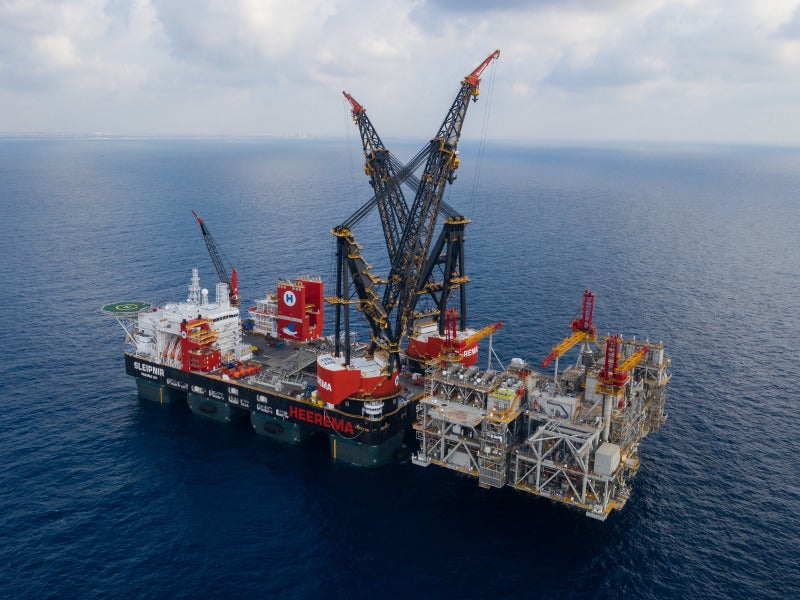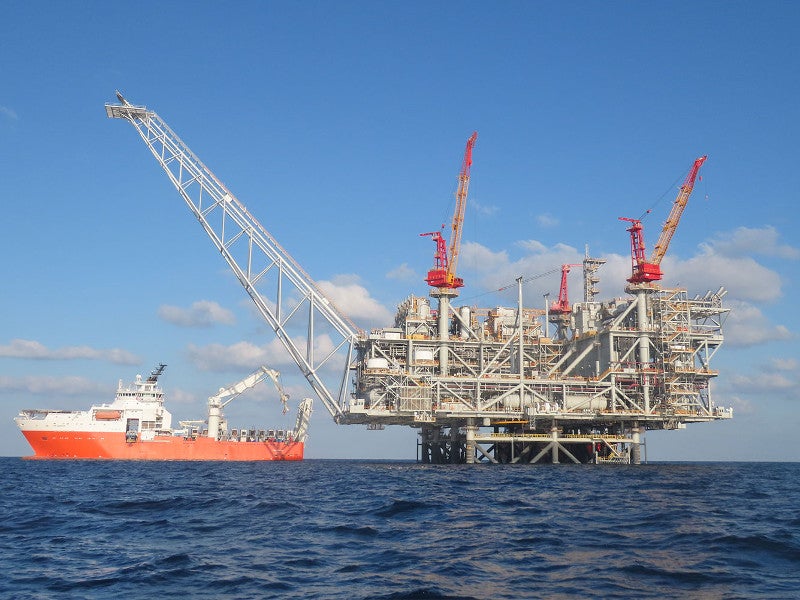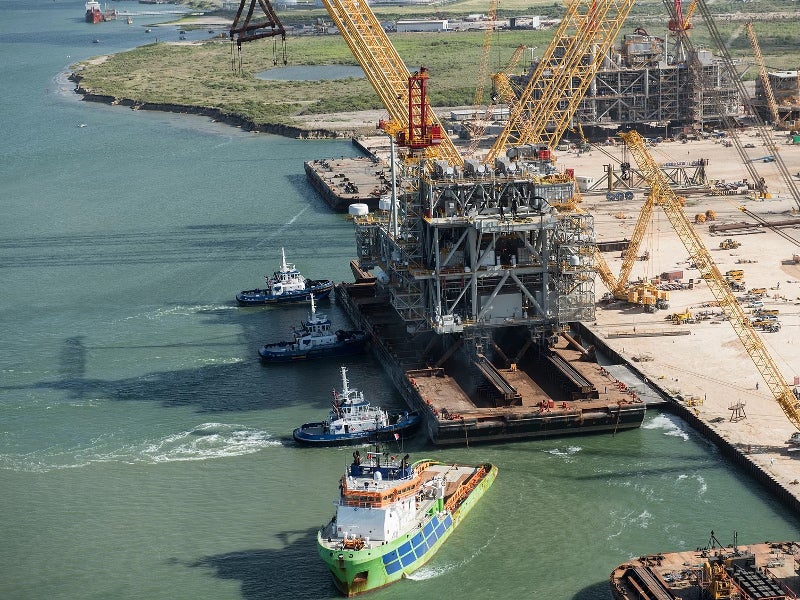The Leviathan gas field is located in the eastern Mediterranean Sea off the coast of Israel. It is estimated to contain natural gas reserves of approximately 605 billion cubic metres (bcm), while condensate reserves are estimated to be 39 million metric barrels (Mmbbl).
The gas field is operated by the Houston-based oil and gas exploration and production company Noble Energy, which holds 39.66% stake in the field. Delek Group’s subsidiaries Delek Drilling and Avner Oil Exploration hold a stake of 22.67% each, while Ratio Oil Exploration owns the remaining 15% interest in the field.
In November 2016, HSBC Bank and JP Morgan agreed to provide a $1.75bn loan to Delek Group to fund the first phase of the field development.
The project partners made the final investment decision in February 2017. The estimated investment for the phase one development is $3.6bn (€3.25bn). The annual natural gas production capacity is estimated to be 12bcm (1.2bcf/day).
The natural gas from Leviathan field will help Israel reduce the use of coal in power production. The field will also make Israel a natural gas exporter for the first time, with off-take agreements from Egypt and Jordan.
Israel’s Mediterranean coast is also home to Tamar and Karish-Tanin fields. Gas production from the Tamar field was started in April 2013, while Karish-Tanin is expected to come on stream in 2021.
Leviathan gas field location and infrastructure
The Leviathan gas field is located in Leviathan Basin in the Eastern Mediterranean Sea, approximately 125km away from Haifa. The water depth of the field varies between 1,540m and 1,800m.
The field is spread over approximately 330km² and comprises four production wells drilled to a depth of more than 5km below the sea-level.
The production flowlines connect the wells to the central infield gathering manifold, which transmits natural gas to a fixed platform. The processed gas will be transferred from the platform to an onshore tie-in point at Dor, through a 32in-diameter subsea pipeline.
In July 2019, the Leviathan field partners entered agreements with Golar LNG and Exmar to conduct front-end engineering design (FEED) studies for a proposed floating liquefied natural gas (FLNG) facility for the field.
Leviathan production platform details
The 38,000t Leviathan production platform (LPP) is located 10km off the coast of Dor, Israel. The natural gas flows from the manifold to the platform through two 120km-long subsea pipes.
The topside of the platform comprises multiple modules and units including a domestic supply module, a liquid storage module, a mono-ethylene glycol reclamation unit, and staff living quarters. Mono-ethylene glycol is used to suppress hydrate formation along pipelines and wellheads.
The lower level of the Leviathan platform lies at a depth of 86m below sea level, while the upper deck is located at a height of 47m above sea level. The LPP measures 102m-long and 80m-wide.
Natural gas export from Leviathan
Israel will be exporting natural gas for the first time with the commencement of production from the Leviathan gas field in January 2020. Leviathan will supply gas to Egypt through the East Mediterranean Gas (EMG) pipeline.
Also known as Arish-Ashkelon pipeline, the 90km-long EMG subsea pipeline is located between Ashkelon in Israel and Al-Arish in Egypt. The annual capacity of the EMG pipeline passing under the Mediterranean Sea is approximately 7bcm. Originally built to supply gas from Egypt to Israel, the pipeline commenced operations in 2008.
Israel, Cyprus, and Greece are planning to build the EastMed pipeline to transport natural gas from the Eastern Mediterranean region. The gas produced by Israel and Cyprus will be fed into the pipeline. The 2,100km-long subsea and onshore pipeline is expected to start operations in mid-2020.
Off-take agreements
The project partners agreed to sell natural gas to Egyptian gas trading company Dolphinus.
In December 2019, Israel’s Ministry of Energy authorised the export of natural gas from Israel to Egypt. As per the permit, 60bcm and 25bcm of gas can be exported from Leviathan and Tamar fields respectively, for a period of 15 years starting from January 2020.
The partners also entered a pact with Jordan’s National Electric Power Company (NEPCO) to sell 45bcm of gas over a period of 15 years. NEPCO will receive between 3bcm and 3.5bcm of gas a year.
Israel-based Bazan Group agreed to buy natural gas condensate produced from the Leviathan field.
Contractors involved
British firm John Wood Group provided FEED and detailed engineering services for the project.
Ensco provided drilling services for the four production wells of the field. The work was executed by the ultra-deep-water drillship ENSCO DS-7.
A crane vessel from Heerema Marine Contractors was involved in the installation works at the field. Sleipnir, the world’s largest semi-submersible crane vessel, installed two topsides on the platform.
Heerema awarded a sub-contract to EEW Special Pipe Constructions to make 16 pin piles for the Leviathan gas rig.
Trendsetter Engineering, a company based in Houston, US, supplied subsea production equipment for the project, including multiple clamp connection systems, subsea distribution equipment, MEG filter modules, and subsea manifolds.
Sweden-based engineering group Sandvik supplied stainless steel tubes for the umbilicals, while GATE Energy offered commissioning services for the project.
Bay, a company based in Texas, US, built the gas rig staff’s living quarters module. Israel-based Habonim supplied more than 10,000 valves for the project, including control valves, Trunnion mounted ball valves, standard valves, and compact actuators.
Allseas, an offshore pipelay and subsea construction services provider, was involved in laying the subsea transmission pipeline for the project.
Schlumberger supplied and installed a 2,200t monoethylene glycol reclamation unit (MRU) for the project.
OneSubsea, a subsidiary of Schlumberger, supplied 10,000-psi horizontal production trees, tree-mounted controls, off-tree controls, and topside controls for the Leviathan gas field.





